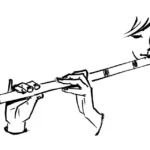When anyone thinks of an accomplished musician, finger dexterity is often the first image that comes to our mind. However, if you ask accomplished flute players, they will often say that breath control is a core skill that needs to be developed.
Over the years, I have been experimenting with many approaches and exercises for developing breath control. I’ve taken those exercises that have been most valuable for me and shared them in the online flute lessons for beginners on my website. Here I am taking the opportunity to share glimpses of those practices. The best way is to learn is through face to face with a teacher who is familiar with these practices. However, I’m hoping that most people can pick them up from the descriptions below.
The main exercise, long notes, is a core practice used by classical woodwind players. The other exercises come from the practice of Pranayama – a branch of yoga that is centered primarily on breath exercises.
Breath signifies LIFE. We as bansuri players are so very blessed to have an instrument which requires the life force itself. In the process of practice, we learn to understand the breath and also master regulating the breath to play the bansuri.
LONG NOTES: The Primary Breathing Technique
The long note practice is simple yet difficult at the same time. Plain long notes with no change in volume. Even players with a lot of experience will find this exercise challenging at first! In our gharana, there is a great emphasis on playing long notes. Students are encouraged to play long notes for at least an hour. This also develops stamina and swar-gyan(knowledge about the notes).
Step-I:
Inhale deep. Play ‘SA’ the primary note as long as you could. Keep a small table clock in front of you to measure time. Repeat this process for at least 10 minutes. Every time try your best to be consistent in playing the SA for the same duration. For example – in the first attempt, you were able to play SA for 10 seconds. Make sure that you play SA for 10 seconds in every attempt during your practice time.
Step – II
After 10 minutes of SA practice. Play ‘RE’ for 5 long notes. Then each Swara for 5 long notes. Lower Sa – Higher Sa and then Higher Sa to Lower SA. Sing the swara in your mind while playing. If you will not sing, then your mind will start wondering and the practice will not bring any fruit to you. This practice will take nearly 45 minutes.
Step-III
Continue this practice for at least three weeks. You will find the difference and improvement in the texture and depth of the sound. A particularly challenging part of long tones for many players is the end of the note. I usually recommend this exercise to all my beginners online flute class students
Secondary Breathing Techniques
Pranayama is always recommended. The specific pranayama exercises like DIRGHA, UJJAI, KAPALBHATI and BHASTRIKA will add additional benefits and strengthen your physical system. (These pranayama exercises must be learnt from a qualified yoga practitioner)
Long notes and pranayama exercises can be for your well-being and not just in becoming a better flute player. You can take time to integrate into a daily practice session or do it during your free time. Try to understand each technique: how it is done, how long to practice it, and how your body and mind respond to it. You can visit my website www.themysticbamboo.com and find the details of breath practice in the online flute lessons for beginner section.
With good playing posture, when you practice these breathing techniques, you will succeed (Find Tips To Improve Your Bansuri Technique). I wish and hope that you enjoy your life’s journey with bansuri. Never forget to be patient with yourself. It demands constant and lots of focused practice to train the body and mind. It’s a beautiful journey from a mere student of music to a musician.




